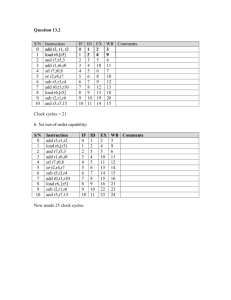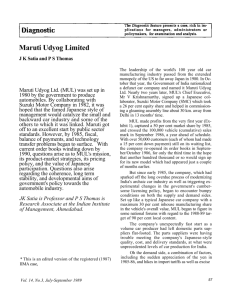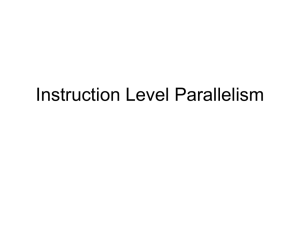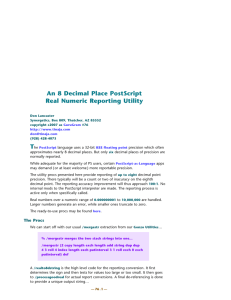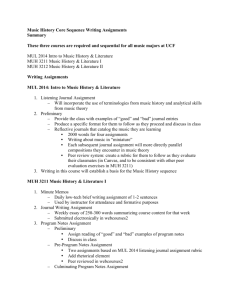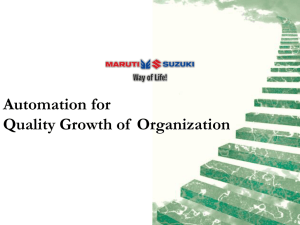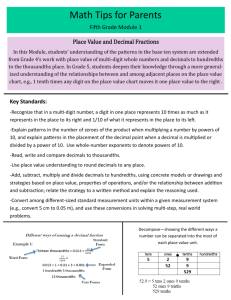Competition and Corporate Strategy in the Indian Automobile
advertisement
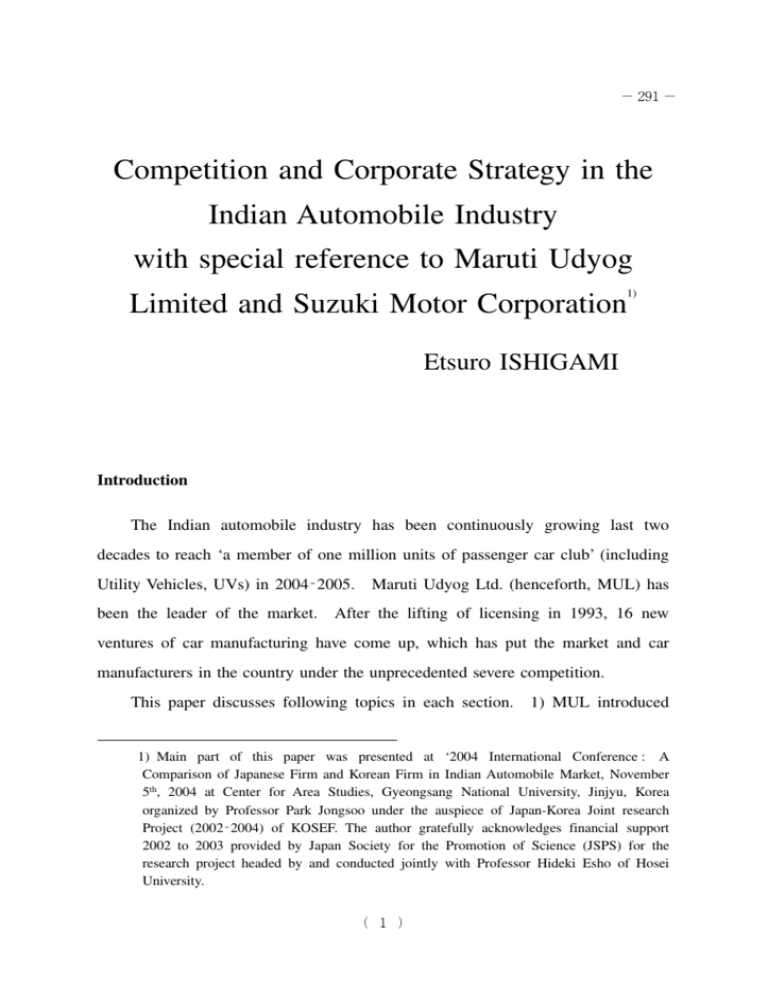
−2 91− Competition and Corporate Strategy in the Indian Automobile Industry with special reference to Maruti Udyog 1) Limited and Suzuki Motor Corporation Etsuro ISHIGAMI Introduction The Indian automobile industry has been continuously growing last two decades to reach ‘a member of one million units of passenger car club’ (including Utility Vehicles, UVs) in 2004‐2005. been the leader of the market. Maruti Udyog Ltd. (henceforth, MUL) has After the lifting of licensing in 1993, 16 new ventures of car manufacturing have come up, which has put the market and car manufacturers in the country under the unprecedented severe competition. This paper discusses following topics in each section. 1) MUL introduced 1) Main part of this paper was presented at ‘2004 International Conference : A Comparison of Japanese Firm and Korean Firm in Indian Automobile Market, November 5th, 2004 at Center for Area Studies, Gyeongsang National University, Jinjyu, Korea organized by Professor Park Jongsoo under the auspiece of Japan-Korea Joint research Project (2002‐2004) of KOSEF. The author gratefully acknowledges financial support 2002 to 2003 provided by Japan Society for the Promotion of Science (JSPS) for the research project headed by and conducted jointly with Professor Hideki Esho of Hosei University. ( 1 ) −29 2− quite a new production and management system first in India, which were basically common to Japanese car manufacturers. Some referred the change in the automobile industry triggered by MUL’s to Maruti Revolution. We will point to MUL’s achievement and the remaining issues up to the mid‐1990s. 2) The latter half of the 1990s saw massive entries and set-ups of the new ventures both from car manufacturing and automotive component manufacturing. With the commencement of production by new entrants, particularly Hyundai Motor’s compact car production, MUL faced real challenge in the industry first time since its inception. Suzuki Motor Corporation (SMC) left the fifty-fifty equity holding and assumed the management control in 2002, which helped MUL metamorphose into more competitive manufacturer. 3) We analyzes some financial parameters of MUL in terms of the transaction relationship between the parent company, SMC, and its subsidiary, MUL, showing the latter’s financial contribution to the former. Indian Automobile and Automotive Component Industry : Maruti Revolution and Some Issues up to the mid‐1990s2) Historical Background3) The seed for local manufactures in India was sown by the establishment of the two vehicle manufacturing plants, Hindustan Motors (HML) and Premier Automobiles (PAL) in 1944. In 1953, the Government of India prohibited the import of cars and assembly activities by foreign car manufacturers to encourage local production of vehicles by the establishment of a component manufacturing base. Since then both HML and PAL continued to monopolize passenger car production for thirty years until 1983 when the joint venture between Suzuki 2) This section is based on author’s earlier research note, Ishigami [2001]. 3) Cf. ACMA [1996], p.1. ( 2 ) Competition and Corporate Strategy in the Indian Automobile Industry with special −2 93− reference to Maruti Udyog Limited and Suzuki Motor Corporation(ISHIGAMI) Motor and Maruti Udyog Ltd. (MUL), a central government public enterprise, initiated its first production. car manufacturing. MUL was the only new entrant into the passenger Until MUL was born, the industry was reconciled to around 40,000 cars in early 1980s. The number of the car production increased remarkably since 1984 with MUL’s entry. However, joint ventures for passenger car production between Isuzu and HML, Nissan and PAL, Honda and Tata Engineering and Locomotives Company (TELCO), and Citroen and Escorts were all rejected by the Government. MUL achieved a remarkable success in a very short period since the commencement of manufacturing Maruti 800, which was often called “Maruti Revolution.” In the area of commercial vehicles, Bajaj Tempo, TELCO and Mahindra & Mahindra entered and started their manufacturing. In early 1980s, a number of other Indo- Japanese joint ventures were set up in the private sector two-wheeler and light commercial vehicle manufacturing. Japanese joint ventures in the commercial vehicle manufacturing were not successful. 1990s saw further liberalization of the economy. With the broad ranging liberalization policy of 1991, the industrial licensing procedure was got rid of. In 1993, the Government completely liberalized the entry of foreign automobile manufacturers. The latter half of the 1990s saw many (too much) entries and set- ups of the new joint ventures both from car manufacturing and automotive component manufacturing. With the commencement of production by new entrants, as we discuss it later, the competition seeking for the larger market shares has been intensified, coupled with the due erosion of MUL’s share. Maruti Revolution Before MUL came into existence, the production of passenger car in India, ( 3 ) −29 4− manufactured by HML and PAL, was low and remained around only 40,000 vehicles for almost two decades. However, within three years of starting production, MUL expanded its capacity to 100,000 units per annum. “MUL marked a radical departure for the Indian auto industry”, with the following distinctive features summarized by Humphery, Mukherjee, Zilbovicius and Arbix [1999]4) : 1) Production of a relatively modern small car design : It was fuel-efficient and cheap, and its overall quality was much superior to its competitors. 2) Location away from established industries areas : The MUL plant was set up on a greenfield site at Gurgaon in Haryana State. Although close to New Delhi, the plant drew its labour force predominantly from surrounding agricultural areas. PAL was situated in Bombay and HML in Calcutta-both hot spots of labour militancy in the 1970s and 1980s. 3) Achievement of scale economics : Within three years of starting production, MUL expanded its capacity to 100,000 units per annum. 4) Suppliers network : MUL developed a suppliers network which imitated some of features of the Japanese suppliers system as it existed in early 1980s. Further, Suzuki introduced its own management style in various ways, mostly known as Japanese way of management, from plant design to work organization. With much positive evaluation to MUL’s management from SMC side, Mohanty, Sahu and Pati [1994] summarized it as follows : 1) The layout of the factory of MUL is on similar pattern of Suzuki. 2) Machinery and equipment are identical. 3) The organisation structure and the staffing of people follow Suzuki’s style in entirety. 4) Humphery, Mukherjee, Zilbovicius and Arbix [1999], p.132. ( 4 ) Competition and Corporate Strategy in the Indian Automobile Industry with special −2 95− reference to Maruti Udyog Limited and Suzuki Motor Corporation(ISHIGAMI) 4) Quality circles have been introduced. 5) The entire work forces are well-informed about the organisation’s emphasis on high quality and productivity as in Suzuki. 6) Efforts are initiated to develop the sense of commitment of the employees to work and company goals through posters, literature, speeches, meetings, etc. just as in Suzuki. 7) The feeling of oneness i.e. all are equal and equally important to the company, is instilled through common uniform, common canteen, common transport, common official work place with no hierarchy anywhere as in Suzuki. 8) People are sent to Japan to know Japanese way of working much more than the technology or details of actual job. 9) Japanese experts are called to do actual work for long durations (up to two years) in all areas of work in MUL. for each expert. Indian counterparts are also identified This ensures learnings of not only technology, but also their approach to a particular problem and its solution5). When MUL entered car production, many automotive component manufactures of the country were operating at rather low levels of technology and production base. Suprious parts are quite common in the aftermarket, which is another indication of the industry’s low level. In fact, in 1995, Automotive Component Manufacturers Association of India (ACMA) described main characteristics of the industry as follows : 1) Small scale. Small scale industries (SSI) firms, 6000 firms, in the ‘un- organised sector’ account for 94 per cent in terms of number of firms and 40 per cent of output. ‘Organised sector’ firms’, 350 firms, average sales is 5) Mohanty, Sahu & Pati [1994], p.135. ( 5 ) −29 6− only about $4 million. The Indian auto parts industry’s small size and relative fragmentation limit its ability to capture the economies of scale necessary for success in the global industry. 2) While generally quite fragmented, the industry is highly consolidated within certain component groups. These are engine valves, fuel injection pump, pistons, wheels, spark plugs, gaskets, steering gears and transmission gears. 3) The relative isolation of the industry from the world market−inbound and outbound−offers protection, but also limits the competitive pressure that drive improvement. 4) A wage-based low-cost position as the source of competitiveness. The industry’s cost advantage is labour-based and significant in the global market−assuming equivalent quality and functionality. 5) The industry appears profitable, and in fact more profitable than its American and European counterparts−understandable given isolation and other factors such as lack of OEM vertical integration, demand is higher than supply and government protection6). ACMA also indicated that a critical obstacle to better performance was the low quality of sub-suppliers to the industry. This was the same situation in ASEAN Four at that time. Confronting the situation, MUL stepped up its own efforts to accelerate the indigenisation process by setting up joint venture projects with the vendors. 6) ACMA [1995], pp.3∼8. Tomozawa [1999] vividly illustrates variety of suppliers with various origin in the Delhi Metropolitan Area (NOIDA and Greater NOIDA), classifying the automotive component firms into six categories : a) OEM suppliers, b) Second-tier supplier, c) Job work, d) Exporter, e) Replacement parts supplier and f) Manufacturer of production facility. ( 6 ) Competition and Corporate Strategy in the Indian Automobile Industry with special −2 97− reference to Maruti Udyog Limited and Suzuki Motor Corporation(ISHIGAMI) MUL continued to enhance the production capacity and the upgradation of manufacturing facilities of potential vendors with the help of some investment opportunities being tied up through the financial agencies. As a result MUL has been able to attain 90.58 per cent indigenisation for Muruti 800, nearly 87 per cent for Omni and about 66 per cent for its Gypsy jeep by the end of the period 1989‐907). The indigenisation ratio of Maruti 800 is more than 95 per cent for domestic sales in late 1990s. One should note that this was achieved by the positive cooperation from Japanese suppliers side as well, sometimes their crosskeiretsu operation found. Also MUL brought about a profound effect on the automotive component industry. That is one of the reason why the entry of MUL is called ‘Revolution’. Humphery, Mukherjee, Zilbovicius and Arbix describe the effect and MUL’s way and characteristics of inter-corporate relationship : Firstly, it increased the scale of the whole industry. Secondly, it raised quality standards among existing component manufacturers. Thirdly, it introduced the ideas of partnerships and tie-ups between assemblers and suppliers. In its public discourses on suppliers, the company has consistently emphasized trust, partnership and continuous improvement. Located on a greenfield site away from the traditional auto producing areas, MUL set about creating a suppliers network which would be capable of sustaining an operation which bought a high proportion of the value of its cars from its suppliers. In order to do this, it brokered the formation of joint ventures between Indian and foreign firms (many of them suppliers to the minority partner in MUL, Suzuki) and established an industrial park for its suppliers close to the plant. By the mid‐1990s, it had brokered 45 7) Mohanty, Sahu & Pati [1994], pp.135∼137. Also, see Shimane [1999]. ( 7 ) −2 98− technology tie-ups (26 with Japanese companies, 19 from other countries) and set up 12 joint ventures producing 23 per cent of the values of MUL’s bought in parts. These were for critical, high-value parts with large investment requirements. It held small equity stakes in a number of these suppliers, in the manner of the Japanese Keiretsu. The supplier network created by MUL shows many of the characteristics of obligational (as opposed to arm’s-length) contracting. Relationships are long-term, and contract allocation procedures are not open. The supplier’s quality record and its understanding of the customer’s requirements are critical. Suppliers and customer are mutually dependent, and there is intense and multi-channeled communication between them8). Some Issues MUL’s success which has been achieved in the highly protected and price consciousness domestic market put forward some issues at the same time. one relates to the quality and product development. First The characteristics such as highly protected and price consciousness put the company less incentives to match the quality consciousness and develop new product for long time. Oba9) shows very interesting surveys concerning the quality of the passenger cars. Maruti cars were ranked low, particularly for low price ranging and vintage products, Maruti 800 and Maruti Omni, while Honda City, Ford Escort and Daewoo Cielo were ranked high. Under the recent very competitive circumstances, even in the small car segment, high quality products are requested by users who have lots of 8) Humphery, Mukherjee, Zilbovicius and Arbix [1999], pp.132∼133. As for MUL’s improving vendor relationship, see also Shimane [1999]. 9) Oba [1999], pp.99∼102. ( 8 ) Competition and Corporate Strategy in the Indian Automobile Industry with special −2 99− reference to Maruti Udyog Limited and Suzuki Motor Corporation(ISHIGAMI) information on cars and related products. In this sense, the crucial point to improve the industry’s competitiveness is to upgrade the technology level of the automotive component to meet the more sophisticated/wide range of auto parts for new cars to come. Indian ‘big’ automotive component firms are not big but rather smaller to the Japanese and international standards. All the assembler are, at present, very active to meet the demand for the higher level products with less cost on the one hand and invite their group and long-trading automotive components firms from home country on the other hand. These efforts are made by company or group basis. Therefore, as we referred to an ACMA’s report in this section, it will need other agenda to bottom up the whole industry. MUL faced these issues, however, the company was not to consider it as a serious problem or a threat to it until the real competitors, Hyundai Motor India10) and TELCO (the largest commercial vehicles manufacturer in India), entered aggressively into the industry with the popular compact cars. The competition and the corporate strategy of MUL since the late 1990s onwards MUL has never encountered the real, serious competition in the business area of the compact car segment until Hyundai Motor and Tata Motors (former TELCO) made each sensational debut in the industry (see Table 1 and Figure 1). The issues above mentioned, and more issues turned out to be urgent subject matters to MUL which were to be solved in a short time : the slow decision making due to 50‐50 equity holding (‘the deemed Public Sector Undertaking’) 10) With regard to Hyundai Motor’s entry and its clustering automotive component firms in India, see Park [2004]. ( 9 ) −3 00− Table 1 Manufacturer wise Production Trend of Cars in India 1998∼2003 (Passenger and Commercial Vehicles, calendar year, units) Manufacturer Maruti Udyog Tata Motors* Hyundai Motor India Mahindra & Mahindra (M & M) Ashok Leyland Toyota Kirloskar Motor Change over 2002 Market Share 437,347 288,998 153,747 (23.1%) (37.3%) (42.0%) 37.3% 24.6% 13.1% 1998 1999 2000 2001 2002 2003 343,348 118,565 8,676 393,837 181,965 58,660 348,665 181,093 88,350 356,633 173,614 88,860 355,198 210,429 108,250 72,150 75,269 67,006 61,964 72,320 94,782 (31.1%) 8.1% 26,588 − 36,679 − 34,661 21,514 32,036 28,418 32,643 25,985 45,122 37,481 (38.2%) (44.2%) 3.8% 3.2% Ford India Honda Siel Cars Hindustan Motors Eicher Motors Bajaj Tempo GM India − − 23,886 5,379 9,216 3,279 − − 25,933 6,399 10,137 2,388 − − 29,568 8,036 9,359 7,311 9,347 7,276 24,063 9,197 6,860 7,783 15,429 13,183 23,415 12,442 8,737 8,401 18,790 (21.8%) 15,737 (19.4%) 15,654 (▲33.1%) 13,965 (12.2%) 13,610 (55.8%) 12,238 (45.7%) 1.6% 1.3% 1.3% 1.2% 1.2% 1.0% Fiat India Automobiles Swaraj Mazda Skoda Auto India DaimlerChrysler India Volvo India Tatra Trucks India 12,197 3,040 − 1,355 − − 20,096 3,374 − 414 − − n.a. 5,045 − 752 − − n.a. 6,101 − 1,217 − 72 32,111 7,579 − 1,158 353 173 11,924 (▲62.9%) 9,635 (27.1%) 1,916 ( − ) 1,396 (20.6%) 203 (▲42.5%) 123 (▲28.9%) 1.0% 0.8% 0.2% 0.1% 0.0% 0.0% 627,679 815,151 801,360 813,441 Total of the Industry 927,806 1,172,668 (26.4%) 100.0% Note : Tata Engineering and Locomotive Co. Ltd. (TELCO) changed its name to Tata Motors in July 2003. (Data) ACMA & Society of Indian Automobile Manufacturers (SIAM) (Source) FOURIN, Sekai Jidousha Geppou, No.227, July 2004, p.6. and the ‘dispute-prone partnership’ for the initiative of the top management between both sides, the need for introduction of the new models, the need for the quality and efficiency improvement to the close level of the mother plant in Japan, the need for building-up of quality and cost conscious suppliers/vendors net work and the need for the better industrial relation, particularly wage agreement based on not the production volume but on the cost, etc. Also, at the same time in the course of its seeking for corporate strategy in the midst of Mega-competition, MUL made a decisive option to take in a strategic (1 0) Competition and Corporate Strategy in the Indian Automobile Industry with special −3 01− reference to Maruti Udyog Limited and Suzuki Motor Corporation(ISHIGAMI) alliance with and under the umbrella of General Motors (GM) so as to survive in the industry, particularly seeking for the technological and brand strength of GMs’ in the category of the medium and the higher-end cars11). GM’s aim was to put SMC=MUL as a pivotal firm manufacturing compact cars in Asia and an export platform of the cars to all the areas but North America and Japan. Soon after its introducing new models such as Wagon R, Alto LX and Alto VX in Indian market since 1999, MUL was to face a hard-hit industrial relations issue. In Gurgaon factory, there was a labour dispute which began with tool down agitation in September 2000 initiated by the union concerning the revision of production target and improvement in pension package, following the then decreasing trend of the MUL’s share of the passenger cars market. The dispute, ‘strike’, lasted for a little more than two months with the loss of a half of the production target during that time and ended with basically MUL’s control, introducing the new incentive scheme effective from November 1, 2000 which gave incentives based on increased productivity and quality of production. The topic showed MUL’s wage, work incentives and management style introduced by the Japanese firm, SMC, had not necessarily been accepted by the Indian employees and also by MUL’s 50 : 50 shared control with the Government shadowed down in the area of industrial relations12). The incidence, indeed, was 11) GM has been in ‘business partnership’ with SMC since August 1981 and took 20.3 per cent equity participation in SMC in September 2000. 12) Venkata Ratnam [2000]. “With both managers and workers of Maruti still wear (ing) the same uniform and eat (ing) lunch at the same canteen even during the period of agitation, after two decades partnership, Japanese way of dealing with labour did not take roots in the company. Some managers in the company argue that the present dispute is the result of a past legacy. During mid‐1990s, in the midst of a tussle between Government of India and Suzuki Motor Company over the succession of the then Managing Director, R. C. Bhargava, the workers got a soft deal in the revision on incentive scheme because they supported the Government. ” (1 1) −30 2− Table 2 Segmentation of MUL’s Models Segment Length Classification Price Classification Model M 800 Alto Baleno Esteem Wagon R Zen Versa Omni A1 Mini A2 Compact A3 Mid-size A3 Mid-size A2 Compact A2 Compact UV UV A B C C B B C A Note : Length based classification introduced by SIAM in April 2002 is as follows : Segment A1 (Mini) −cars having a length of up to 3,400mm ; A2 (Compact) −of 3,401∼4,000mm ; A3 (Mid-size) −of 4,001∼4,500 mm ; A4 (Executive) −of 4,501∼4,700mm ; A5 (Premium) −of 4,701 ∼5,000mm ; A6 (Luxury) −of more than 5,000mm. (Source) India Infoline [2004] p.2. Figure 1 Manufacturer wise Market Shares of Passenger Vehicles (including UV’s) 2003-04 16% MUL 45% 15% Hyundai Motor India M&M Tata Motors 7% others 17% (Date) SIAM. (Source) India Infoline [2004]p.3. so much shocking to the SMC management that they were prompted to incline progressively to leave the 50 : 50 shared position and grasp the majority share to execute its own way of the management to SMC’s corporate strategy. ( 12 ) SMC got Competition and Corporate Strategy in the Indian Automobile Industry with special −3 03− reference to Maruti Udyog Limited and Suzuki Motor Corporation(ISHIGAMI) the majority share of MUL, 54.2 per cent in May 2002 and assumed the management control13). The competition in the market has witnessed some salient features : 1. India is still an extremely price sensitive market and that can be seen from the phenomenal performance of Maruti 800. segmentation of MUL’s models. Table 2 shows the M 800 is the only model in A1 (mini) segment, ‘an entry model’ for the upper-middle class, has monopolized the segment. The price of the lowest model starts with around Rs. 200,000. MUL has 47.7 per cent market share in A2 (its competitors are mainly Hyundai Santro and Tata Indica), and only 10 per cent share in A3 segment which has been the fastest grown segment recently. In A3 and A4 segment, such models as Hyundai Accent, Ford Ikon, Honda City and Opel Corsa etc. have progressively attracted consumers in the market albeit on a smaller in terms of absolute numbers. In the UV segment where diesel engine vehicles dominate this segment with a share of 95 percent, MUL enjoyed a meager share of 2.5 per cent14). 2. When we see the company-wise performance in the market, we can point the followings with distinction. in A and B segment. MUL holds the dominant position particularly Hyundai Motor India Ltd (HMIL) came up as the second producer of 100,0000 units per year in a short period after incorporation. Also, Tata Mortor has emerged as the first indigenously developed small car producer. In the meantime, the Government of India announced a new ‘Auto Policy : 13) The Government of India, a promoter of the company, holds 18 percent. Other main shareholders are as follows : Foreign Institutional Investors 15.2 percent ; Mutual Funds and Unit Trust of India 5.6 per cent and Indian Public 5.3 per cent (MUL [2004]). 14) MUL [2004] and India Infoline [2004]. (1 3) −30 4− Vision To Establish A Globally Competitive Automotive Industry In India And To Double Its Contribution To The Economy By 201015)’ in March 2002, saying to emerge as a global source for auto components ; to establish an international hub for manufacturing small, affordable passenger car. Lowering of the excise duty for cars and the 150 per cent tax deduction on in-house research and development16) (R&D) scheme followed it to be conductive the Vision. We can argue a few points about the significance of the corporate strategy in the Indian car market. First. Suzuki=MUL and Hyundai share a similarity that both firms achieved the production of 100,000 units per year in a shorter period and had export strategy from India to the Europe, the Middle East and the Latin America17). As the world second/third-tier major car manufacturers, they had a view that India was neither ‘niche’ nor ‘test for some time’ market but the market for their future and global penetration. India is rich in well educated/cheap human resources and the industrial base for engineering and machining. The Japanese car majors worked out their Asian business strategy ASEAN first, then China and the South Asia lastly. Second. As is well known, there are so many global Indians, who know cars in the developed countries well and have close ties with people in India, also well educated on the latest car information. model in India will be kicked off. A car maker to introduce an old HMIL is of late struggling for assure its position in the C segment (Sonata) and D segment (Elantra) whose consumers are 15) GOI [2004] 16) In general, R & D expenditure of auto makers in India has been very poor. For instance, the figure of MUL, the industry leader was just 0.42 per cent to the net sales. (MUL [2004]) 17) In 2003‐04, MUL exported 51,175 units, Alto being the main item accounting 34,399 units for Europe. Hyundai and Tata are also major exporters and total export of of the passenger cars by the country is 129,316 units. (SIAM and MUL [2004]) (1 4) Competition and Corporate Strategy in the Indian Automobile Industry with special −3 05− reference to Maruti Udyog Limited and Suzuki Motor Corporation(ISHIGAMI) so much sensitive to quality, technology and brand image. These issues should be tackled by the company on the basis of the global solution. Third. The entry of Hyundai Santro and Tata Indica implies a real threat to MUL, the small car giant, for the first time. They say MUL introduced the Japanese management system, more or less, successfully. The experience of the recent rationalization shows MUL had still lots to do in terms of productivity, quality management, industrial relations and vendor/delivery system. We show just a couple of cases : the percentage of direct pass vehicles improved from 19.5 per cent in 2000‐01 to 80.3 per cent in March 2002. ; The attendance rate went up from around 91 per cent in 2000‐01 to 97 per cent in 2001‐02 with introduction of new worker incentives scheme linked to attendance18). MUL’s Annual Report presents remarkable improvement in the other area of its operation. The company started “Challenge 50” campaign (2001‐02 to 2004‐05) with the target of 50 per cent increase of productivity. It was achieved by 2003‐04 : 20 hours per vehicle to complete at MUL plant while 11 hours at Kosai I plant, SMC. Also, Inventory holding period reduced from 30 days in 2002‐03 to 19 days in 2003‐04. In the area of suppliers management, MUL has reduced its vendor base from over 350 in 2001‐02 to around 220 at the end of 2003‐04. It helped MUL enhance supply chain efficiencies by lowering the time and costs involved in dealing with more vendors19). All the measures taken for the higher efficiency helped MUL improve the financial and operational indicators of 2003‐04 (see Appendix 1 and 2), some of which are discussed in the following section. 18) The Managing Director of MUL, Jagdish Khatter’s article “How Maruti Innovated Work Practices to Advantage”, Business Standard, online ed . August 15, 2004, accessed on the day. 19) MUL [2004]. Furthermore, The company raised its rating in the area of customer orientation by J D Power Survey 2000 and 2003, particularly concerning the items such as ‘good reputation of make’ and ‘good technology’ (1 5) −30 6− Is MUL the goose laying the golden eggs to Suzuki? Some financial parameters We can get some knowledge about ‘Transfer Pricing’ through a text book on ‘International Business’, but, rarely encounter actual facts showing the matter by any existing company. In April to May 2003 newspapers in India reported Suzuki’s concession to the Government of India and MUL during a talk on disinvestment process with the headline “Royalty Waiver on 5 Maruti models ; 10 per cent cut in transfer price” saying20) : The Japanese company (Suzuki Motor Corporation, SMC) would not charge royalty on Maruti 800, Zen, Omni, Gypsy and Esteem models. SMC would get royalty on the Euro-Ⅲ models of these cars to be launched later. -----Another concession that SMC agreed on pertained to 10 per cent reduction in the transfer price. This would apply to all spares and components that SMC would supply to its Indian subsidiary, MUL. The impact of these concessions on the MUL balance sheet has been estimated to be quite substantial, sources said. It would be in the range of Rs 40 crore on profit after tax for 2002‐03. MUL paid a royalty of Rs 117 crore in 2001‐02, up from Rs 62 crore in the previous fiscal. According to Annual report 2003‐04, MUL’s expenditure with related parties are as follows (figures in million Rupees)21) : 20) The Financial Express, online ed ., April 2, 2003 accessed on October 18, 2004, also The Hindu Business Line, online ed ., May 26, 2003. (A crore equals to ten million) 21) MUL [2004] p.74. The detail of the transactions with related parties are clarified in Appendix 3. ( 16 ) Competition and Corporate Strategy in the Indian Automobile Industry with special −3 07− reference to Maruti Udyog Limited and Suzuki Motor Corporation(ISHIGAMI) Purchases of good Royalty Joint Ventures 662 − Associates SMC 12,118 − 9,707 1,134 Fellow Subsidiaries 385 − Total 22,872 1,134 The amount of the royalty payment to SMC was Rs 2 crore to Rs 7 crore in 1980s and then increased in tune with the uptrend of MUL’s car production to the recent level of around Rs 110 crore. This is the substantial contribution of SMC’s operation in India, MUL, to the parent company in Japan because SMC’s net profit (not consolidated) has been in the range from Rs 500 crore to Rs 1000 crore and the share of car segment in terms of profit earning is at best half of the amount, the rest from two wheeler sector22). With regard to the transaction of components and parts, it will be plausible to estimate that SMC has so far retained somewhat level of margins and will keep certain level of margins even after the 10 per cent reduction of the transfer price. This kind of business practice, transfer price, should be found all the firms operating as MNC, not quite unique to MUL-SMC case. Taken account from the royalty payment and the transaction of goods, therefore, MUL has made financially substantial contribution to SMC. In other words, SMC has operated its joint venture, then its subsidiary, MUL very successfully. We can point to some more characteristics of MUL’s financial structure. Firstly, the continuous growth of the company has helped her accumulate ample internal financial resources, become borrowing free company/harvest financial 22) SMC [2004] pp.3∼49. SMC produced more than 570,000 units in Asia (excluding China), in which MUL contributed 437,000 units, 75 per cent of the region’s production. Asian operation as a financial segment contributed a turnover of Yen 464.8 billion and Profit before tax Yen 24.9 billion in 2003‐04, which surpassed the figures of both North America and Europe, next to Japan. (Nippon Jidousha Chousa Geppou, No.69, December 2004, pp.34‐35) (1 7) −308− earnings and invest large amount money to foster the group suppliers and the insurance company as well. In 2003‐04, MUL’s debt equity ratio was just 0.1 and its earnings of the financial assets (interest and dividend) more than Rs 200 crore. Secondly, MUL’s efforts to transplant its parents company’s way of production management and the suppliers relationship in Gurgaon factory has achieved high level of efficient production and product quality. Owing to these achievements, it has lowered the production cost to sales ratio around 94∼95 per cent in late 1980s to 75 per cent in 2003‐04, which enables the company to afford increasing sales promotion and advertisement spending23) under the progressively competitive automobile market. Thirdly, MUL enjoys the advantage of the relatively much lower employees’ cost based upon its higher productivity. In 2003‐04, the employee cost was Rs 295.5 crore (of which Voluntary Retirement Scheme accounted for Rs 119.6 crore), and its ratio to sales was only 3.2 per cent which was almost as half as Tata Motors, 6.7 percent24), while the figure reflected the company’s effort such as ‘Challenge 50’. It is quite interesting to collect corresponding figures of Japanese car manufactures in Japan (not consolidated, in 2002‐03) : SMC, 5.7 per cent ; Honda, 10.8 per cent ; Toyota, 8.6 per cent ; Nissan, 9.3 per cent25). Thus we may say MUL has created the labour cost minimizing auto factory in India, following the parent company’s reputation ‘never ending effort to the lowest cost manufacturer in Japan.’ The cost competitiveness of MUL deriving from the above 23) The outlay on advertisement and promotion has on average been 7 per cent (The Hindu Business Line, online ed ., July 22, 2003, accessed 18 October, 2004). 24) MUL [2004] p.57, 65 ; Tata Motors Limited, Audited Financial Results for the year ended March 31, 2004. 25) These figures are sourced from Nihon Keizai Shimbun [2002]. (1 8) Competition and Corporate Strategy in the Indian Automobile Industry with special −3 09− reference to Maruti Udyog Limited and Suzuki Motor Corporation(ISHIGAMI) mentioned factors are to be the basis for its export strategy for the time being. In 2004, SMC announced the major expansion and diversification plan in Indian operation such as 1) to set up a joint venture with MUL to build a manufacturing facility with an annual production capacity of 250,000 units in Haryana state, first car to come up by early 2007, 2) to set up a new two-wheeler manufacturing facility also in Haryana, 3) MUL to become SMC’s R&D Center in Asia by 2007, also to work out a new model for Zen for export and 4) to invest Rs. 3500 million to set up a new diesel engine manufacturing facility with an annual production capacity of 100,000 by a licensing agreement with Fiat Auto and Adam Opel, both GM group companies, for 1.3 liter diesel engine26). These announcement of new corporate plans immediately faced arguments from the Government, a co-promoter and former partner with 18 per cent equity holding of the company, referring to such topics as the process of the decision making, the future position of the Government in the company and the viability of the new ventures and business etc. The real challenge to SMC=MUL, obviously, will not be to argue with the Government, but, to take in rather new area of the compact and mid-sized car production with more value addition, also the company’s first experiment of progressively competitive market. diesel engine manufacturing, in getting We will discuss the matter in another paper from the standpoint of global restructuring of the industry and the position of those in India and Asia in the process. 26) Nippon Jidousha Chousa Geppou, No.69, December 2004, pp.34‐35. (1 9) −31 0− Appendix One : Balance Sheet of Maruti Udyog Ltd. 2003‐04 (Non-Consolidated) (Rs.in Million) SOURCES OF FUNDS SHAREHOLDERS’ FUNDS Share Capital Reserves and Surplus LOAN FUNDS Secured Loans Unsecured Loans DEFERRED TAX Deferred Tax Liabilities Deferred Tax Assets Total APPLICATION OF FUNDS FIXED ASSETS Gross Block Less : Accumulated Depreciation As at 31.03.04 As at 31.03.03 1,445 34,467 35,912 1,445 29,535 30,980 3,119 − 3,119 3,000 1,560 4,560 3,088 (1,255) Capital Work-In-Progress INVESTMENTS CURRENT ASSETS, LOANS AND ADVANCES Inventories Sundry Debtors Cash and Bank Balances Other Current Assets Loans and Advances LESS : CURRENT LIABILITIES ANO PROVISIONS Current Liabilities Provisions Net Current Assets MISCELLANEOUS EXPENDITURE (to the extent not written off or adjusted) Total (Source) MUL [2004] p.56. (2 0) 45,667 27,359 18,308 749 1,833 40,864 19,057 16,773 4,388 (2,317) 45,138 22,581 22,557 93 4,398 6,894 2,402 751 5,744 20,189 4,870 6,711 9,894 598 5,755 27,828 12,144 3,174 15,318 11,359 3,427 14,786 2,071 37,611 22,650 1,032 4,871 13,042 163 887 40,864 37,611 Competition and Corporate Strategy in the Indian Automobile Industry with special −3 11− reference to Maruti Udyog Limited and Suzuki Motor Corporation(ISHIGAMI) Appendix Two : Profit and Loss Account of Muruti Udyog Ltd. 2003‐04 (Non-Consolidated) (Rs. in Million) For the Year ended 31.03.04 INCOME Gross Sales Less : Excise Duty Net Sale Income from Services Other Income Total EXPENDITURE Consumption of Raw Materials and Components Purchase of Traded Goods Consumption of Stores Employees Remuneration and Benefits Manufacturing, Administrative and Other Expenses Selling and Distribution Expenses Financial Expenses Provision for Contingencies Depreciation Deferred Revenue Expenditure Charged Off Less : Vehicles/Dies for Own Use (Accretion) /Decretion to Work-in-progress and Finished Goods Profit for the year Total Profit before Tax Less : Tax Expense -Current Tax -Deferred Tax -Previous Years Profit after Tax Add : Brought forward from previous year’s account Profit after tax available for appropriation Less : Appropriation : Debenture Redemption Reserve General Reserve Proposed Dividend Corporate Dividend Tax Balance carried forward to Balance Sheet Basic/Diluted Earning Per Share (in Rupees) (Source) MUL [2004] p.57. (2 1) For the year ended 31.03.03 112,840 19,384 93,456 278 3,776 97,510 89,679 18,414 71,265 136 2,765 74,166 66,349 3,512 516 2,975 3,735 6,662 457 93 4,949 724 89,972 128 89,844 (32) 89,812 7,698 97,510 7,698 2,515 (238) − 5,421 23,359 28,780 52,590 3,085 415 2,212 2,843 4,796 518 371 3,221 386 70,437 41 70,396 949 71,345 2,821 74,166 2,821 225 1,006 126 1,464 22,699 24,163 175 542 433 56 27,574 18.77 176 146 427 55 23,359 5.14 −3 12− Appendix Three : Statement of Transactions with Related Parties 2003‐04 (Rs. in Million) Joint Holding Fellow Subsidiaries2) Associates3) Ventures1) Company4) Subsidiaries5) Outstanding at year end Loans and advances recoverable Amounts payable Guarantees given to third parties by the Company Proposed Dividend Amount recoverable Interest recoverable Transaction during the year Purchases of Capital items Sale of goods Other Income Rendering of services Finance Income Recovery of Power & Fuel Cost Dividend Royalty Commission Others Expenditure Purchases of goods Royalty Interest Receiving of services Total 23 44 5 − 104 784 − 524 652 37 784 1,389 162 − 38 8 − − − 1 794 − 288 4 − 235 1 − − − 586 25 956 235 913 38 − 58 − − − 2 76 − 1 5,059 77 5,119 − 11 − − − 2 2 − − − − − − − 2 113 73 39 29 120 499 − − − − − − − 8 93 − − − − 7 10 217 73 39 29 122 508 662 − − − − − − 16 12,118 − − − 9,707 1,134 − 13 385 − − − 22,872 1,134 − 29 Note : -The remuneration of Key Management Personnel is included in Managerial remuneration above. -Suzuki Metal India Limited is also an assaciate to Maruti Udyog Limited 1) Joint Ventures 4) Holding Company J.J. Impex (Delhi) Private Limited Suzuki Motor Corporation Mark Exhaust Systems Limited 5) Fellow subsidiaries 2) Subsidiaries Suzuki Europe S A Maruti Insurance Brokers Limited Suzuki France S A Maruti Insurance Distribution Services Limited Suzuki Italia S P A True Value Solutions Limited Suruki Australia Pty. Ltd. 3) Associates Suzuki Austria Automobil Handels GmBH Asahi India Glass Limited Suzuki GB PLC Bharat Seats Limited Magyar Suzuki Corp. Caparo Maruti Limited Suzuki Motor Poland Ltd. Climate Systems India Limited Suzuki Manufacturing Spain S.A. Denso India Limited Suzuki Metal India Limited Jay Bharat Maruti Limited Suzuki International Europe Gmbh Krishna Maruti Limited S. Iberica (including Suzuki Madrid) Machino Plastics Limited Mark Auto Industries Limited Nippon Thermostat (India) Limited Sona Koyo Steering Systems Limited Citicorp Maruti Finance Limited Maruti Countrywide Auto Financial Services Limited (Source) MUL [2004] p.74. (2 2) Competition and Corporate Strategy in the Indian Automobile Industry with special −3 13− reference to Maruti Udyog Limited and Suzuki Motor Corporation(ISHIGAMI) References Automotive Component Manufacturers Association of India (ACMA [1996]), Indian Auto Component Industry : A Status Report---Achieving World Class, ACMA. ACMA [1995], The Future of the Indian Auto Components Industry : Competitive Realities and Necessary Steps, ACMA. FOURIN [1999], Ajia jidousha sangyou 1999 (Asian Automobile Industry 1999) , Tokyo. FOURIN, Sekai Jidousha Chousa Geppou (Monthly Magazine of the World Automobile Industry), various issues. FOURIN, Nippon Jidousha Chousa Geppou (Monthly Magazine of the World Automobile Industry), various issues. Fujimoto, Takahiro, Takeishi, Akira and Nobeoka, Kentarou [1999], “Jidousha sangyou no sekaiteki saihen, kibo koso subete? (Global Restructuring of the Automobile Industry, Is scale all?),” Bijinesu Revyu, Vol.47, No.2, October 1999. Government of India, GOI [2002], Auto Policy : Vision to Establish a Globally Competitive Automotive Industry in India and to Double its Contribution to the Economy by 2010. Humphery, John, Mukherjee,Avinandan, Zilbovicius, Mauro and Arbix, Glauco [1999] “Globalozation, FDI and the Restructuring of Supplier Networks : the Motor Industry in Brazil and India”, in Mitsuhiro Kagami, John Humphery and Michael Piore, Learning, Liberalization and Economic Adjustment, Institute of Developing Economies, Tokyo, 1999. India Infoline [2004], Annual Report Analysis : Maruti Udyog Ltd ., August 3, 2004 (http : //www.indiainfoline.com/sect/maud.pdf. accessed on January 8, 2005) Ishigami, Etsuro [2001], “Indian Automobile Industry and Japanese Firms in an Asian Perspective”, (Research Note), in Fukuoka Daigaku Sogo Kenkyusho Ho, No.244. Japan Automotive Manufacturers Association (JAMA [2003]), 2003 The Motor Industry of Japan, Tokyo. Maruti Udyog Limited (MUL) [2004], Annual Report 2003‐04, New Delhi. Mohanty, Shok Kumar, Sahu, Pramod Kumar and Pati, Subash Chandra [1994], Technology Transfer in Indian Automobile Industry, Ashish Publishing House, New Delhi. Nihon Keizai Shimbun [2002], Nikkei Keiei Shihyo 2003 (Nikkei Financial Analysis 2003) , Tokyo, 2002. Oba, Hiroyuki [1999], “Liberalising the Indian Automobile Industry in Asian Perspective,” Konodai Bulletin of Economics Studies (Chiba University of Commerce), Vol.11, No.1, October 1999. Park, Jongsoo [2004], “Korean Perspevtive on FDI in India : Hyndai Motors’ Industrial Cluster”, Economic and Political Weekly, July 31, 2004, pp.3551∼3555. Shimane, Yoshie [1999], “Indo no jouyousha sanngyouno keiseikatei, kigyou kan kannkei no siten kara (The Process of Building-up of the Indian Passenger Car Industry, From the view point of Inter-corporate relationship),” Ajia Keizai, Vol.40, No.8, August 1999, pp.2∼35. Shimokawa [1999], Reorganization of the Global Automobile Industry and Structural Change of the Automotive Component Industry, Working Paper, MIT. (2 3) −31 4− Suzuki Motor Corporation (SMC) [2004], Annual Report 2004, online ed . Tomozawa, Kazuo [1999], “Delii shutoken ni okeru jidoushakogyou no shuuseki to sono tiiki kozo (Concentration of the Automobile Industry in Delhi Metropolitan Area and its Geographical Structure)”, Tishi-ken Nenpou (ANREG, Hiroshima University), No.8, March 1999. Venkata Ratnam, C. S. [2000], Unrest at Maruti, (mimeo), New Delhi (2 4)

